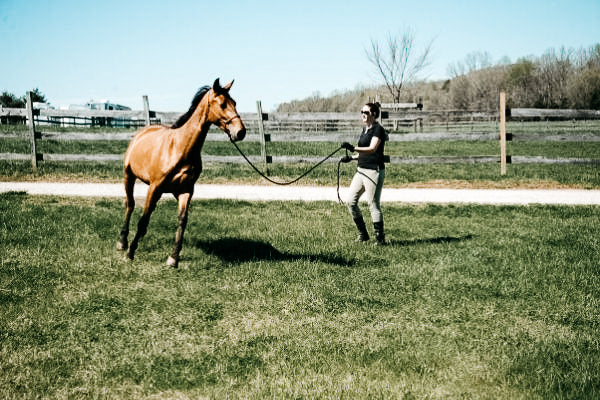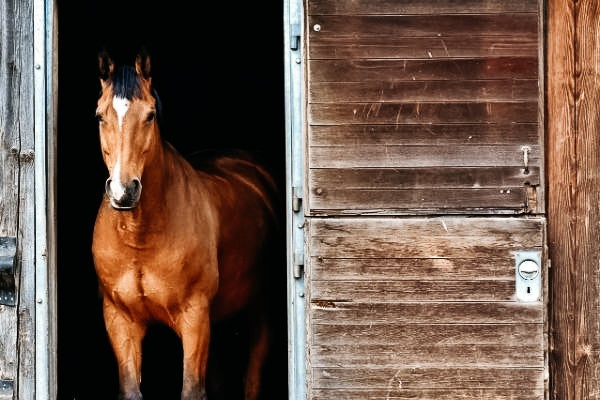
Ground work
Ground work - boring nonsense or varied training opportunity for horse and rider?
A rumor that persists among riders: Ground work is boring.
Let's take a closer look at whether there is any truth to this rumor.
What is ground work?
As the word suggests, it involves working with the horse from the ground. Horse and rider meet here at “eye level”. This results in a much more direct communication with the horse. The horse not only listens to the rider's voice, but also pays more attention to his body language.

Dual activation/EQUIKINETIC:
This is interval training (alternating stress and recovery phases) according to Michael Geitner, which is intended to ensure more balance and targeted muscle building in horses. In this lunging program, the horse is lunged in a continuous inside position. With the help of blue/yellow foam bars, a square volt is created on the ground through which the horse moves.
Natural Horsemanship:
Natural Horsemanship is based on natural horse behavior to gain the trust and respect of horses in the horse-human relationship. This method is mentally, emotionally and physically similar to the way horses behave and communicate with each other in a herd. The aim of natural horsemanship is for people to behave not like people or even like predators, but like horses. The basics are seven games that are based on the behavior of a mare with her newborn foal.
Lung work:
refers to training on the lunge. Here you can specifically build up the horse's muscles. It is also suitable for improving and developing bending and positioning. When lunging, the horse ideally wears a cavesson to send fine signals to the horse's head and neck.
Freedom dressage:
is a communication between horse and rider that works exclusively with hand signals, the whip and guided by the human voice and body language. During this type of ground work, the horse does not wear a halter or other bridle and is, as the name suggests, “free”, i.e. without a lunge or lead rope.
Anti-fright training/compassion training:
Here the horse is confronted with everyday situations and/or objects in which it would often react nervously or even panic due to its natural instinct to flee. This is how you prepare your horse, for example. b on horseback rides. Common aids here are pylons, umbrellas, tarpaulins, fluttering tape, or rattle bags.
Long rein work:
is a great opportunity to exercise the horse from the ground and to refine lessons that may not yet be so well established under the saddle. All the lessons that the horse can show under saddle can also be developed and practiced on the long rein. This option is particularly ideal for horses that cannot be ridden. This type of ground work also trains the muscles and coordination and gives the horse gymnastics. Long rein work is also highly recommended for the rider, where you can refine your aids and perfect lessons. In addition, the rider builds up fitness because long rein work can be carried out in all gaits.
Circus music:
are circus lessons for the horse. These include, for example: b the compliment, rising, Spanish step, bowing and many other tricks.
Clickers:
Click - praise through treats - Click - praise through treats - this is how the clicker is linked as a positive sound by humans to the horse's head. Using this simple link, the horse finds out what the rider wants with a click noise and a treat, and the rider rewards every positive reaction.
The types of floor work listed are of course only a small selection, because the options are very numerous and varied. Not every horse is suitable for every type of ground work or enjoys training. Therefore, you should not just limit yourself to one type, but rather look at several options to filter which types of ground work are suitable for rider and horse.
Ideally, people learn:
- Understanding movements better - how the horse moves in certain situations, in which direction the horse's gaze is directed, this information helps us immensely.
- Interpret body language correctly – from the ground perspective we learn more quickly what the horse is currently doing and how it “works”.
- Peace and composure – for many riders, these appear more quickly when working on the ground than from the saddle.
Aim of ground work
The aim of ground work is to increasingly minimize our assistance so that the horse ultimately reacts to the human through barely visible impulses and carries out the individual exercises in a motivated, precise and calm manner. In addition, a strong bond of trust and respect should be created between rider and horse.
Depending on which type of ground work you choose, there is different equipment.
Here is a brief overview of the most commonly used equipment:
- Holster
- Knot halter
- Casesbridle
- Ground work rope
- Lunge
Optional: crop, whip or horseman stick
Optional: pylons and poles, depending on what you want to practice
Optional: “scary” things for calm training, e.g. b Umbrella or tarpaulin

Conclusion:
So you can see that ground work with the horse, alongside classic riding, is a very important component in the work between rider and horse and should by no means be described as boring. Whether long rein work, lunge, equikinetic or freedom dressage. The possibilities for ground work are numerous and yet they all pursue the same goal. To create a unique, close bond and blind trust between rider and horse. The diverse possibilities of ground work allow you to train your horse in a goal-oriented manner. Relaxation, gymnastics and variety are a nice side effect.

Discover more posts

Types of keeping horses and ponies
Even before buying the new horse/pony, the question arises, where do I keep my horse/pony? Does it prefer to be in a box or is a simple pasture enough for it? There are different forms of hus...
Continue readingIt's finally here - we're really excited to be exhibiting at the equestrian trade fair Horse & Hunting to be represented in Hanover! The Horse & Hunting is a trade fair highlight fo...
Continue reading
